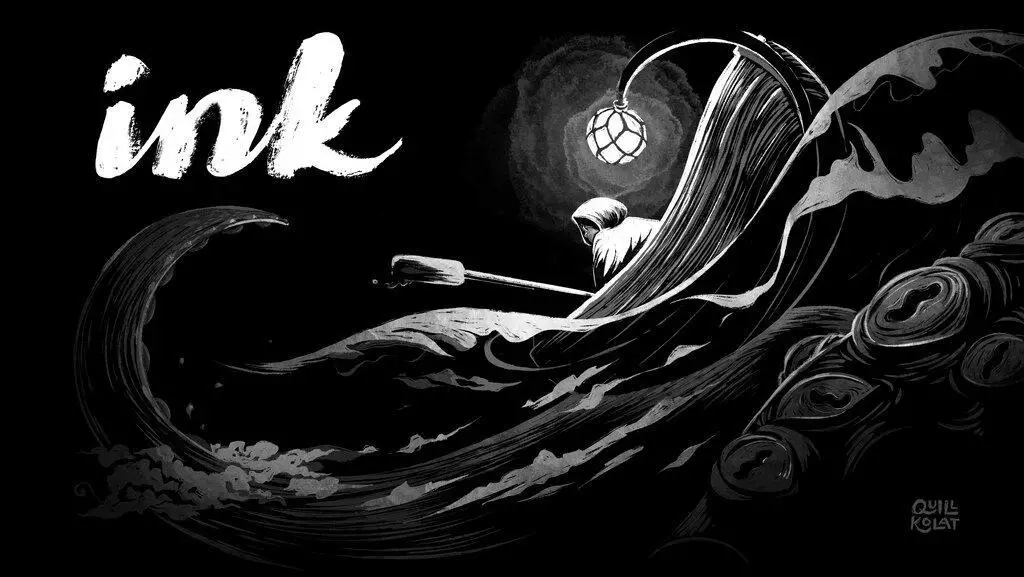
Ink spins the tale of lost souls travelling a murky purgatory to find their way Beyond. Its visual aesthetics are unimpeachable, brilliant black and white pages of mutated ghosts travelling above a black ocean. Its art is both joyous and grim, evoking a strong potential for this setting and the talents of this team. Unfortunately, this is not an art book or a graphic novel; Ink sets out to also be a roleplaying game, and it does not succeed at that task. Its many ideas are unique and inventive, like its roguelike influences that see your party advancing only when all characters die in combat. However interesting those ideas might be, they don’t manage to support a robust or rewarding game. I like a lot about Ink as a book, but I don’t see myself playing or recommending it as a game.
Ink is a small game, running at 102 pages with a few extra pages for art. The book claims that this can be played cooperatively or solo, but the latter is just not true. Monsters have their behaviors and strategies explained well enough for a GM to run them, but not for a single person to program against themselves. Solo play also ignores one of the major mechanics of the game: Spirit and Shadow, and how they interact in combat, because you don’t have anyone to talk (or not talk) with. I will cover that in more detail below, but first I need to discuss some basics.
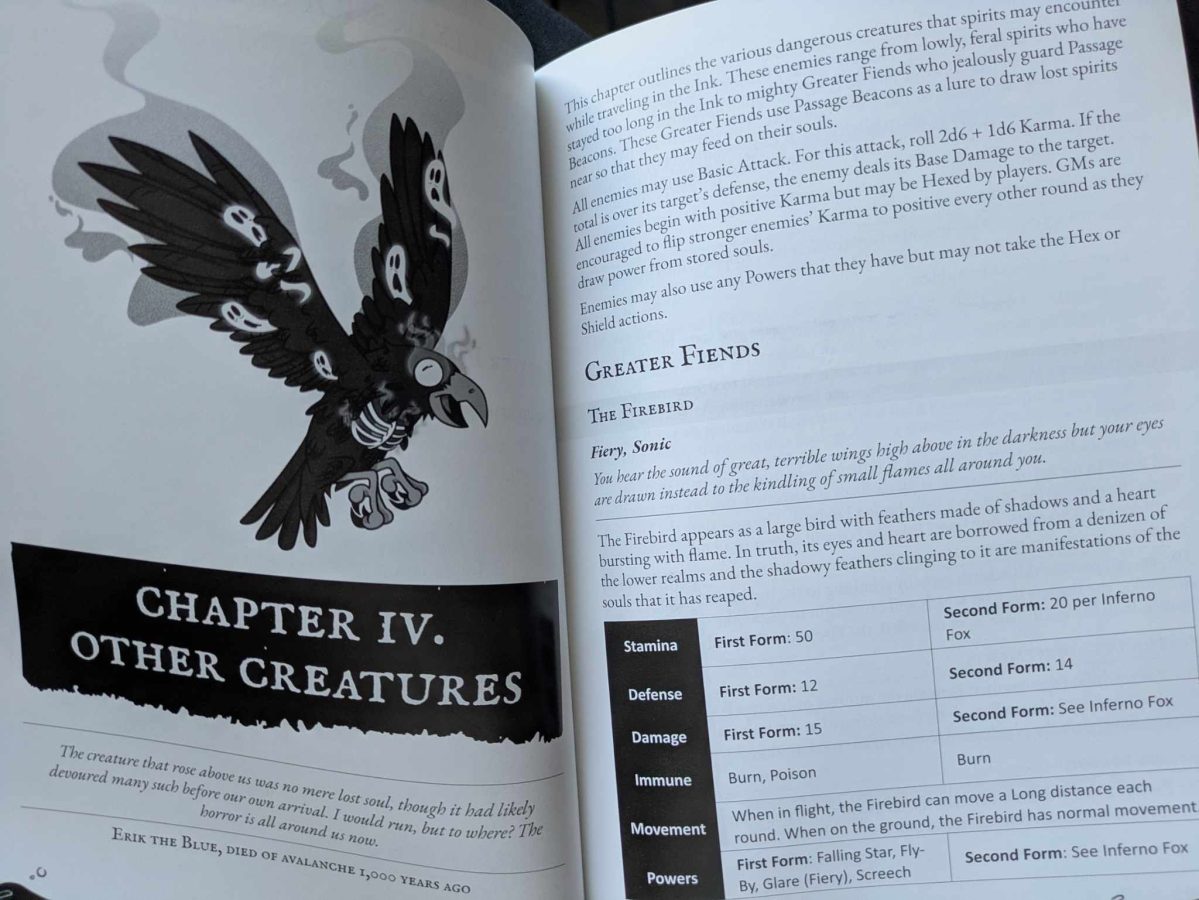
Ink takes place above a sea of endless dark waters that threaten to destroy or mutate spirits that can’t escape. Think Pact’s Abyss or the rising waters foretold by Londor. The spirits are depicted as flying, but you will need to travel the ink via ship. The art also depicts humans, tieflings, and knights, as you can play the deceased version of another RPG character. This lends some inconsistencies to the character designs.
To make your character, you have two options. First, you can find resources on the website at…oh. Oh no. You see the picture below? The picture that shows a blank space on page 11 where there was supposed to be a link? This is a glaring, major oversight that sends a bad message right at the start. I don’t like to talk like this, especially as I’m maybe one of the only people writing a review of this game, but for a resource as important as character creation to just be absent from the text, very early on, is an unacceptable misstep and speaks to a lack of quality control.
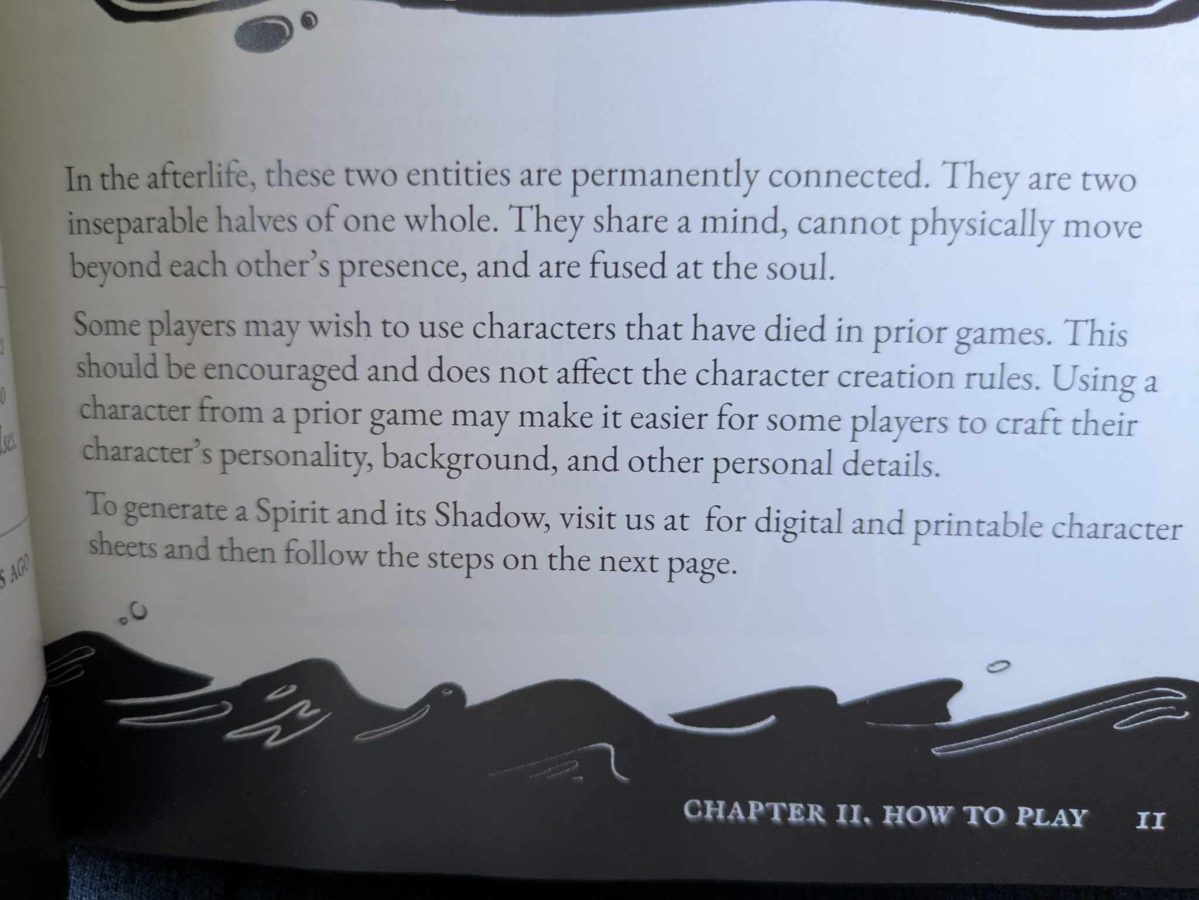
The other method of character creation breaks into Spirit and Shadow. For the Spirit, you choose some background details, a Burden (the unfinished business keeping them from passing on), and three skills. The skills are listed not in this chapter, but many chapters later. There’s no page reference either; compounded with the fact that skills are 26 pages into that chapter, it turns the simple prospect of choosing a few skills into an annoying grind. For your Shadow, you choose from a few different Forms which determine stats and starting powers.
Spirits are the thinking portion of your wayward soul, covering exploration and social encounters. Shadows are the animalistic id, taking control during combat. This has shades of Wraith: the Oblivion, but without the kind of thoughtful development that would make the idea work. Your Shadow can’t go berserk and pull you further into the abyss or force you to make a bad decision; they only manifest by disallowing players from coordinating in any way during combat.
Shadow forms have Stamina, their…huh. That’s strange. The stats are not actually explained in the character creation section. WOULDN’T THAT BE IMPORTANT? Anyway, stamina is health for Shadows. Spirits are totally invincible and have no such stat. Why would you ever switch to Shadow then? I don’t know. The book says that a Shadow will never put its Spirit in danger, but also doesn’t have a mechanic for the Shadow to choose to take over as a response to some kind of need or insult. It wouldn’t be out of threat, because the Spirit can’t be threatened. Shadows also have a base defense score, attack type, and power.
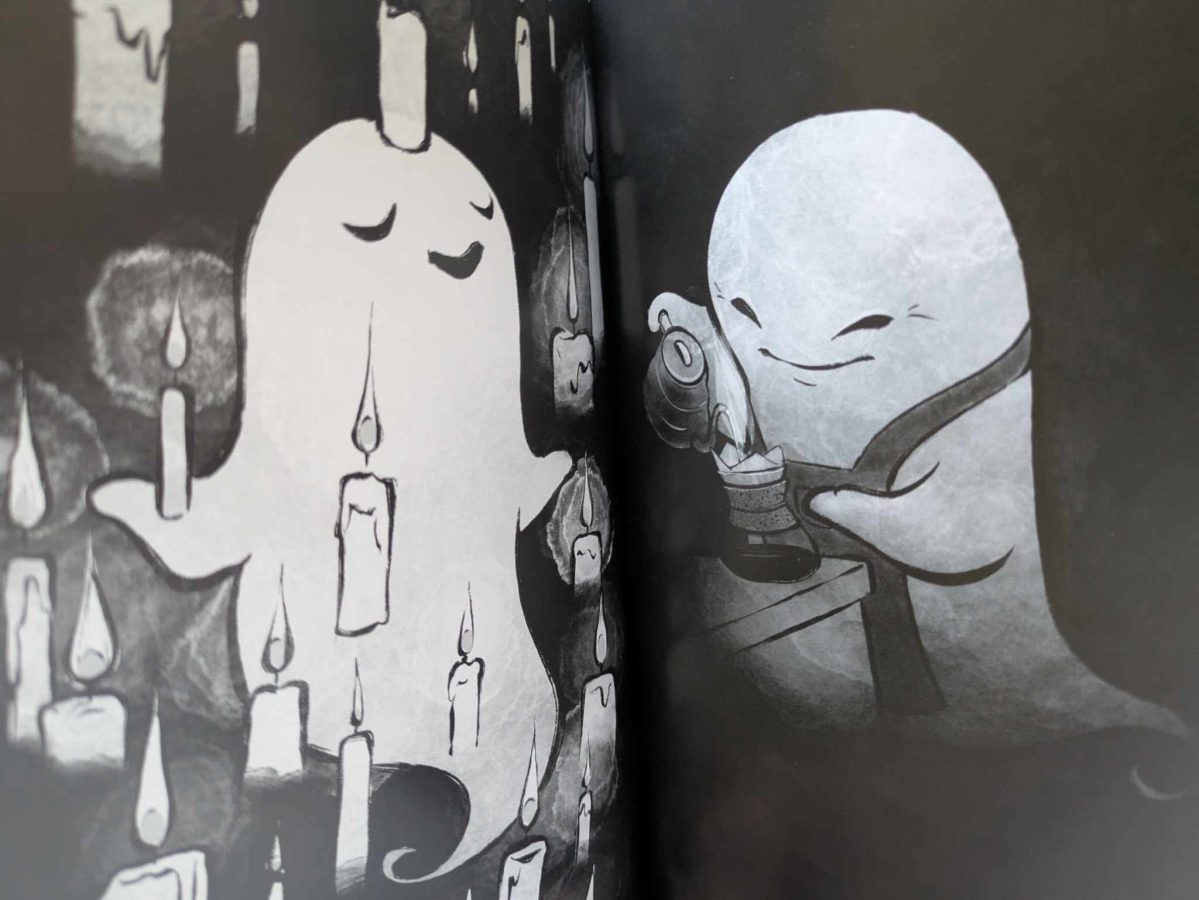
Outside of combat, mechanics are simple: roll 2d6, add or subtract 1 if your Karma is positive or negative, with +2 if you have a relevant skill, and compare against 7 for success. The game doesn’t discuss situational bonuses or penalties, but vaguely suggests changing the base difficulty. It also doesn’t discuss the math behind how hard or easy different values would be. Karma starts positive and can flip negative for…reasons? Combat actions can flip it, but otherwise player’s Karma flips “as a result of their in-game actions.” What result? What kinds of actions flip Karma positive or negative exactly? Karma adds or subtracts 1d6 from every basic attack roll and many power rolls, so its status is critical to success, but what is it? What does it represent and how does it change? The Karma section of the book doesn’t address this, which is another critical oversight by the creators. Even thematically, a game about spirits weighed down by their decisions trying to pass on should be a huge element of the story, but we get barely a paragraph about what it means and how it should affect you.
In combat, players privately choose between basic attack, using a power, flipping an enemy’s Karma, or shielding for half damage. Most attacks have elements, whether Burn, Chill, Poison, Terror, or Sonic. They make penalties on enemies for more stacks of each element, so the only real consideration is how you can use the same element as much as possible until the enemy’s stamina is depleted. After making those choices, all actions occur simultaneously and you can then choose to move.
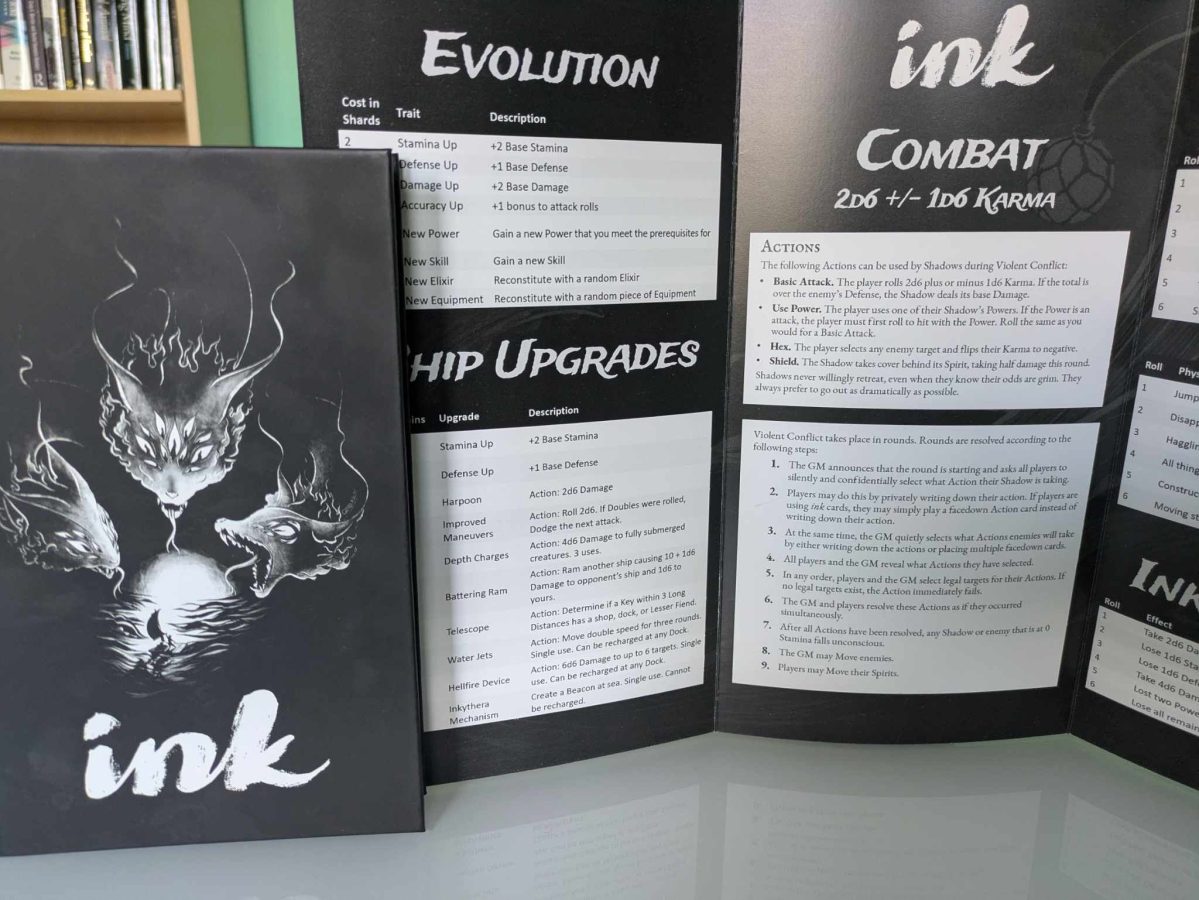
This combat system makes no allowance for other creative decisions. You can’t push over a pillar or use the environment or anything. Only those four specific options, and of them you have nothing interesting to decide on. Maybe one Karma flip, but otherwise it’s using your best element to its best effect or not. There’s just nothing here to go off of. Nothing developed enough to make these decisions interesting. Barely any decisions at all. The powers offer a few small changes, but nothing major enough to really inject some intrigue into this game.
Once every Player Character dies, you reawaken at the last encountered Beacon (safe points) and Evolve, spending accumulated Shards of lost souls for upgrades like better stats, a new power, or random equipment. That death and randomness is meant to play into roguelike elements of the game, but require everyone to die at the same time and assume more interest in retrying similar encounters than a game this simplistic can justify.
You can find Elixirs and Equipment through travel, each of which offer minor bonuses or combat effects. You can also receive taint from the Ink that can temporarily or permanently reduce your stats. There are some fun pages devoted to Fiends, their themes and attack strategies, but with so few stats and powers available to them, it’s hard to imagine making a run at one multiple times and enjoying it. The Journeys section which lays out how to structure adventures provides nice, if basic, details on how to get an adventure running.
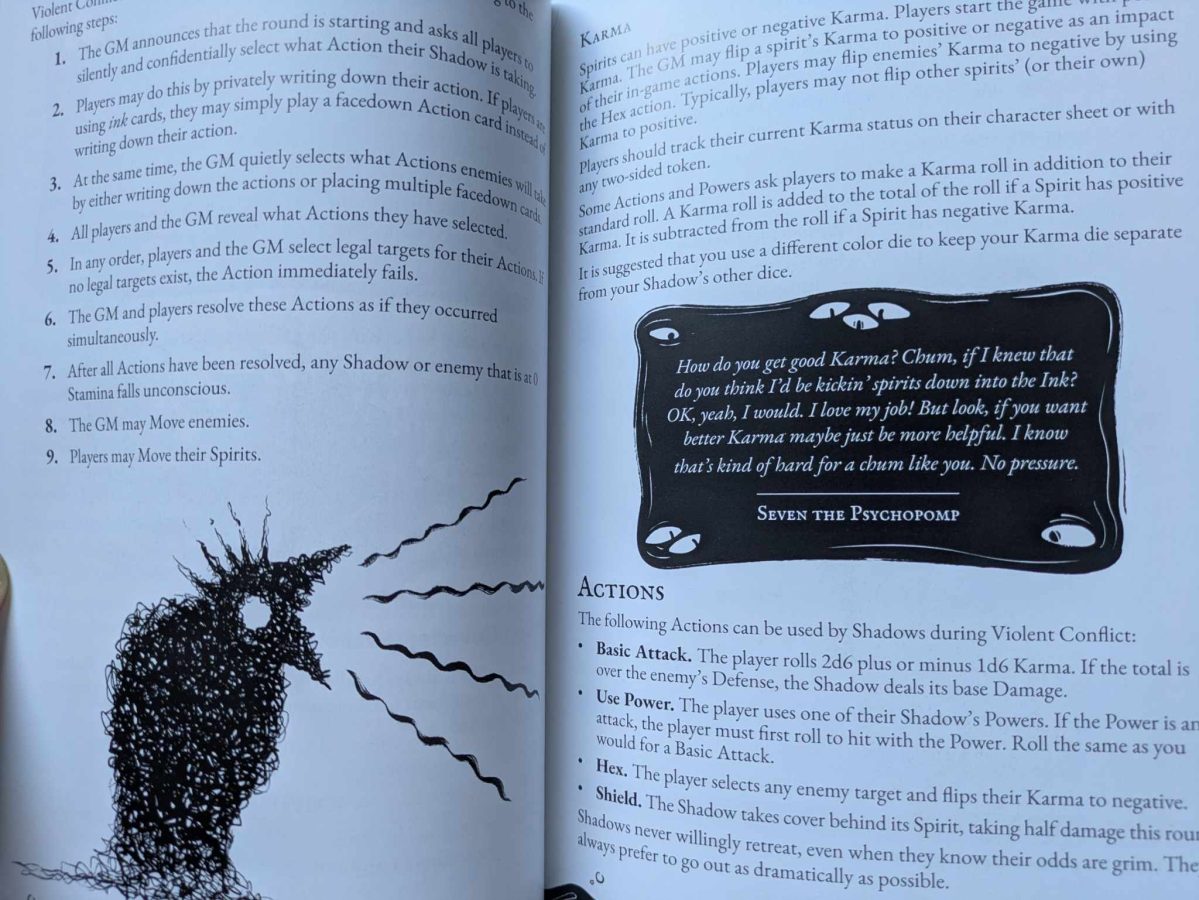
Ship combat rules are the same as those for characters but for the fact that the Captain chooses your action and Navigator your movement. Ship upgrades are dumped randomly in Chapter V along with equipment, Elixirs, Skills, and Powers.
Peppered throughout the book are Elixir Shop info pages, which is a monumentally wasted opportunity. The vast majority of these pages are empty space with some nice art and flavor text. This would be a good place for some notes about their location and rumors about the nearby area, but those kinds of useful GM tools are absent. You get some basic facts and special qualities, but the actual mechanics and prices for Elixirs are in a separate part of the book. The worst thing about these is how they’re scattered haphazardly through the text. If you’re running the game and want to choose from its shops, where do you go? Better start flipping and praying. Even the one at the back of the book is buried behind a dedication and some pages of art. It’s just a thoughtless way to add a resource to an RPG sourcebook.
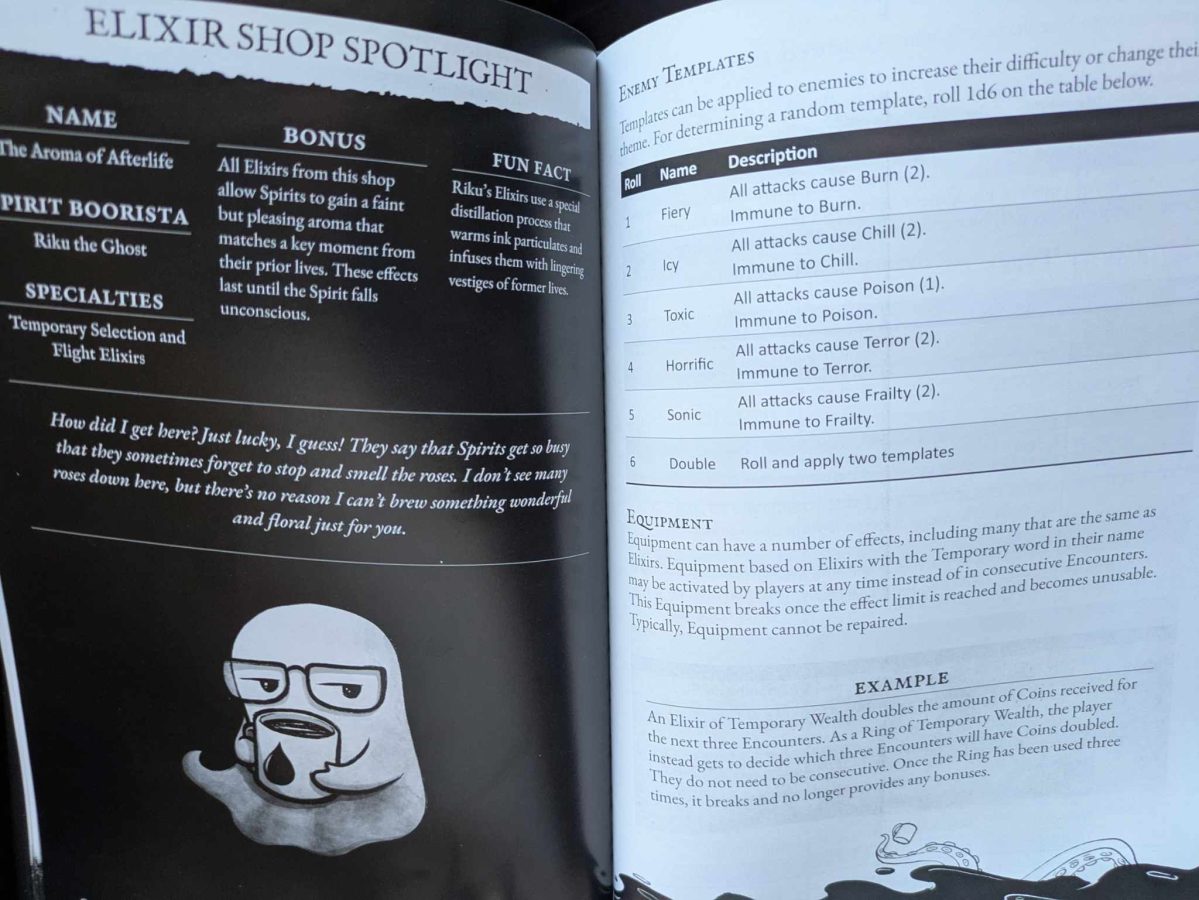
This book has no index and the table of contents only has five entries. Finding anything useful is on you. My advice is that your most useful resources for running a good game are in another book on your shelf. Look, I’m sorry. I don’t want to be mean here. As a reviewer it’s easy to write a review where you can let loose your rhetorical skill with anger at a bad game, but it’s not very kind to the human beings who put their heart and soul into the project. There is beauty and care that went into aspects of this book, but not the parts that would make it a worthwhile game to play or resource to use at the table. This was just not thought out or edited well enough to justify playing through, and that’s before the fact that its extremely minimal mechanics don’t carry the weight they are meant to. I would love to see something else from Snowbright Studio. Something with the same energy and art design, something with the kind of imagination on display with Ink. But that something should either not be an RPG or it should very seriously retool the RPG elements at play.
Ink
Very Bad
Despite some marvelous artwork and generally interesting ideas, Ink does not have what it takes to make for a compelling RPG. It’s arguably playable, but with layout that will fight you, missing character creation resources, and very little engagement with its own most compelling elements. Ink fails at a few basic, foundational elements of game design, with a delivery that falls far short of its own premise.
Pros
- The art, where consistent, is gorgeous and evocative
Cons
- Spirit and Shadow system is undercooked
- Every other mechanic is undercooked, come to think of it
- Missing resources in the character creation section
- Bad layout, references, and organization
